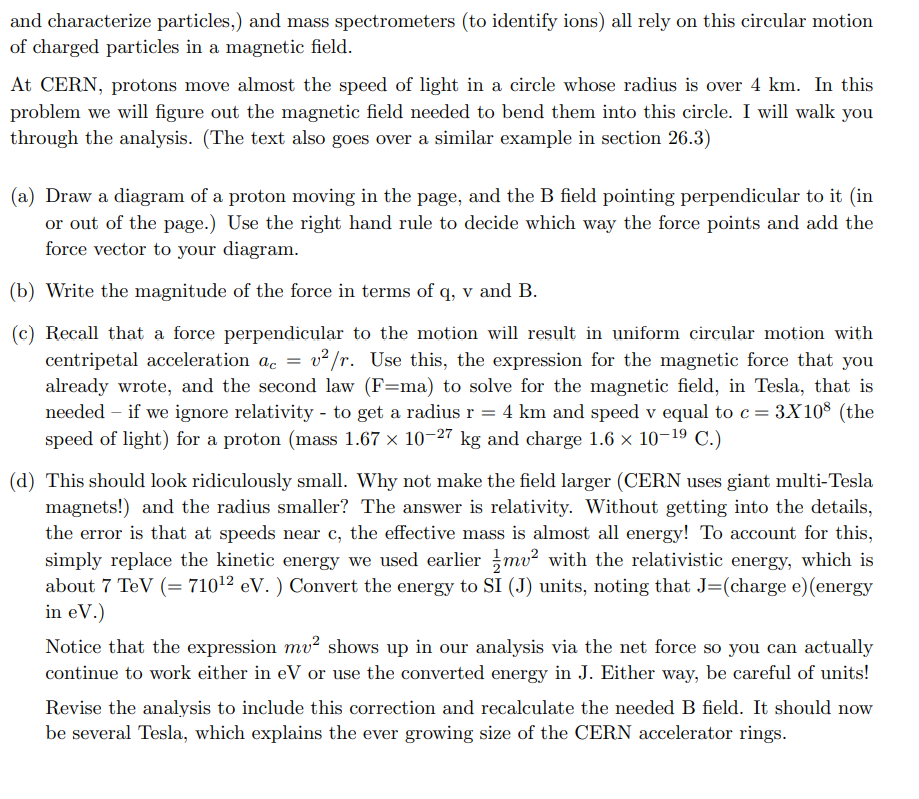(a) Draw a diagram of a proton moving in the page, and the B field pointing perpendicular to it (in or out of the page.) Use the right hand rule to decide which way the force points and add the force vector to your diagram. (b) Write the magnitude of the force in terms of q, v and B. (c) Recall that a force perpendicular to the motion will result in uniform circular motion with centripetal acceleration ac = v² /r. Use this, the expression for the magnetic force that you already wrote, and the second law (F=ma) to solve for the magnetic field, in Tesla, that is needed – if we ignore relativity - to get a radius r = 4 km and speed v equal to c= 3X10$ (the speed of light) for a proton (mass 1.67 x 10-27 kg and charge 1.6 x 10-19 C.) %3D
(a) Draw a diagram of a proton moving in the page, and the B field pointing perpendicular to it (in or out of the page.) Use the right hand rule to decide which way the force points and add the force vector to your diagram. (b) Write the magnitude of the force in terms of q, v and B. (c) Recall that a force perpendicular to the motion will result in uniform circular motion with centripetal acceleration ac = v² /r. Use this, the expression for the magnetic force that you already wrote, and the second law (F=ma) to solve for the magnetic field, in Tesla, that is needed – if we ignore relativity - to get a radius r = 4 km and speed v equal to c= 3X10$ (the speed of light) for a proton (mass 1.67 x 10-27 kg and charge 1.6 x 10-19 C.) %3D
Glencoe Physics: Principles and Problems, Student Edition
1st Edition
ISBN:9780078807213
Author:Paul W. Zitzewitz
Publisher:Paul W. Zitzewitz
Chapter24: Magnetic Fields
Section: Chapter Questions
Problem 79A
Related questions
Question
question in picture

Transcribed Image Text:and characterize particles,) and mass spectrometers (to identify ions) all rely on this circular motion
of charged particles in a magnetic field.
At CERN, protons move almost the speed of light in a circle whose radius is over 4 km. In this
problem we will figure out the magnetic field needed to bend them into this circle. I will walk you
through the analysis. (The text also goes over a similar example in section 26.3)
(a) Draw a diagram of a proton moving in the page, and the B field pointing perpendicular to it (in
or out of the page.) Use the right hand rule to decide which way the force points and add the
force vector to your diagram.
(b) Write the magnitude of the force in terms of q, v and B.
(c) Recall that a force perpendicular to the motion will result in uniform circular motion with
centripetal acceleration ac = v² /r. Use this, the expression for the magnetic force that you
already wrote, and the second law (F=ma) to solve for the magnetic field, in Tesla, that is
needed – if we ignore relativity - to get a radiusr =
speed of light) for a proton (mass 1.67 x 10-27 kg and charge 1.6 x 10-19 C.)
4 km and speed v equal to c= 3X10$ (the
(d) This should look ridiculously small. Why not make the field larger (CERN uses giant multi-Tesla
magnets!) and the radius smaller? The answer is relativity. Without getting into the details,
the error is that at speeds near c, the effective mass is almost all energy! To account for this,
simply replace the kinetic energy we used earlier mv? with the relativistic energy, which is
about 7 TeV (= 71012 eV. ) Convert the energy to SI (J) units, noting that J=(charge e)(energy
in eV.)
Notice that the expression mv? shows up in our analysis via the net force so you can actually
continue to work either in eV or use the converted energy in J. Either way, be careful of units!
Revise the analysis to include this correction and recalculate the needed B field. It should now
be several Tesla, which explains the ever growing size of the CERN accelerator rings.

Transcribed Image Text:A magnetic field turns the velocity of a particle but does not change the speed, because the force is
always perpendicular to the velocity. Particle accelerators (like CERN,) bubble chambers (to detect
Expert Solution
This question has been solved!
Explore an expertly crafted, step-by-step solution for a thorough understanding of key concepts.
Step by step
Solved in 2 steps with 6 images

Knowledge Booster
Learn more about
Need a deep-dive on the concept behind this application? Look no further. Learn more about this topic, physics and related others by exploring similar questions and additional content below.Recommended textbooks for you

Glencoe Physics: Principles and Problems, Student…
Physics
ISBN:
9780078807213
Author:
Paul W. Zitzewitz
Publisher:
Glencoe/McGraw-Hill

Principles of Physics: A Calculus-Based Text
Physics
ISBN:
9781133104261
Author:
Raymond A. Serway, John W. Jewett
Publisher:
Cengage Learning

Physics for Scientists and Engineers with Modern …
Physics
ISBN:
9781337553292
Author:
Raymond A. Serway, John W. Jewett
Publisher:
Cengage Learning

Glencoe Physics: Principles and Problems, Student…
Physics
ISBN:
9780078807213
Author:
Paul W. Zitzewitz
Publisher:
Glencoe/McGraw-Hill

Principles of Physics: A Calculus-Based Text
Physics
ISBN:
9781133104261
Author:
Raymond A. Serway, John W. Jewett
Publisher:
Cengage Learning

Physics for Scientists and Engineers with Modern …
Physics
ISBN:
9781337553292
Author:
Raymond A. Serway, John W. Jewett
Publisher:
Cengage Learning


University Physics Volume 3
Physics
ISBN:
9781938168185
Author:
William Moebs, Jeff Sanny
Publisher:
OpenStax
